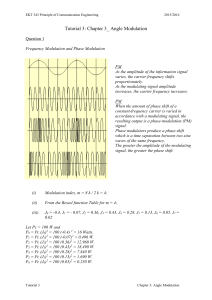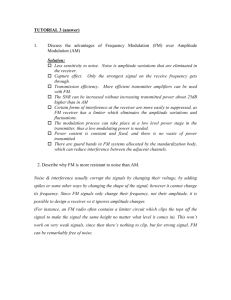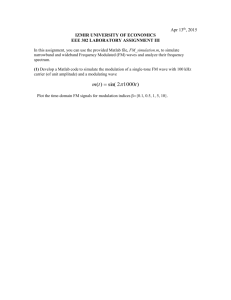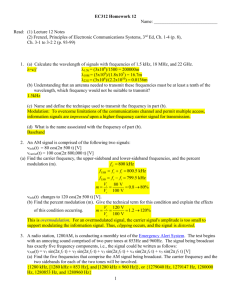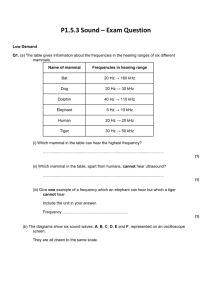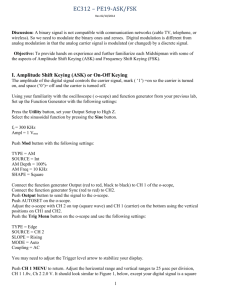tutorial 3
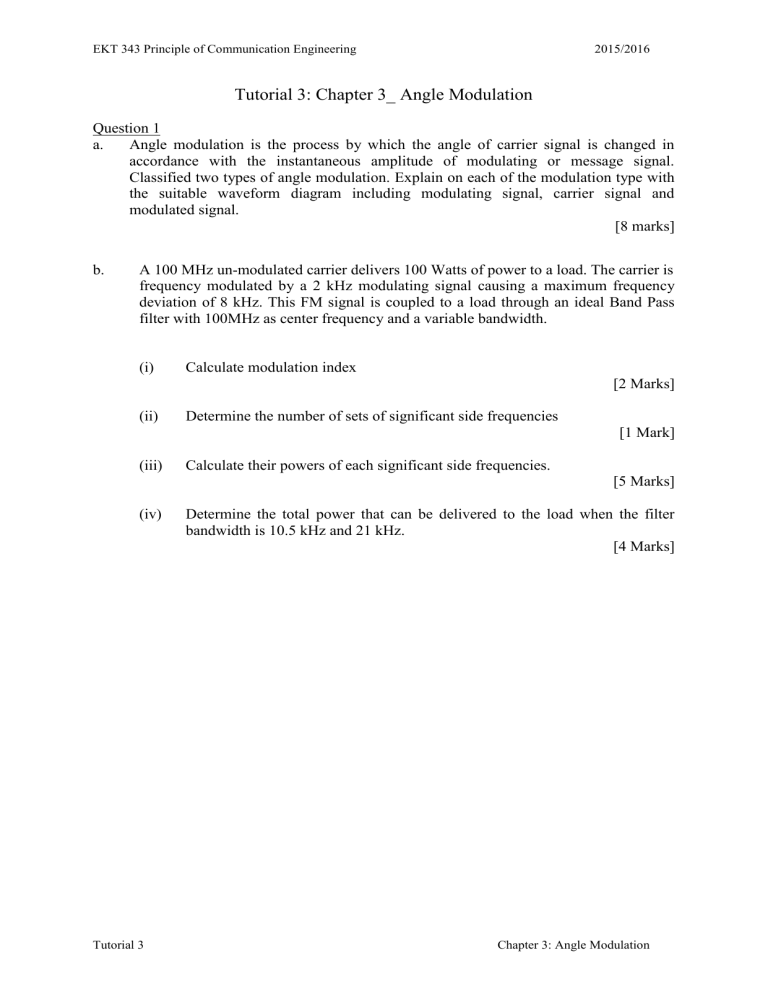
EKT 343 Principle of Communication Engineering 2015/2016
Tutorial 3: Chapter 3_ Angle Modulation
Question 1 a.
Angle modulation is the process by which the angle of carrier signal is changed in accordance with the instantaneous amplitude of modulating or message signal.
Classified two types of angle modulation. Explain on each of the modulation type with the suitable waveform diagram including modulating signal, carrier signal and modulated signal.
[8 marks] b.
A 100 MHz un-modulated carrier delivers 100 Watts of power to a load. The carrier is frequency modulated by a 2 kHz modulating signal causing a maximum frequency deviation of 8 kHz. This FM signal is coupled to a load through an ideal Band Pass filter with 100MHz as center frequency and a variable bandwidth.
(i) Calculate modulation index
[2 Marks]
(ii) Determine the number of sets of significant side frequencies
[1 Mark]
(iii) Calculate their powers of each significant side frequencies.
[5 Marks]
(iv) Determine the total power that can be delivered to the load when the filter bandwidth is 10.5 kHz and 21 kHz.
[4 Marks]
Tutorial 3 Chapter 3: Angle Modulation
EKT 343 Principle of Communication Engineering 2015/2016
Question 2 a.
Both AM and FM systems are used in commercial and non-commercial applications.
Such as radio broadcasting and television transmission. Each system has its own merits and demerits. State an advantage and disadvantage of FM over AM:
[2 Marks] b. The input carrier frequency to a frequency modulator is a 570 kHz signal with an amplitude of 30 V. At the output of this modulator, this signal has been deviated for 9 kHz from its original value. Given the modulation index, m f
of the system = 3.
(i) Calculate the value of modulating signal frequency.
[1 Mark]
(ii) Construct the general equation for the output signal of this frequency modulator circuit [2 Marks]
(iii) Using Bessel Table, indicate the number of sideband pairs produced.
[1 mark]
(iv) Calculate the amplitudes of the modulated output wave.
[2 Marks]
(v) Sketch and label the voltage spectrum of the modulated wave.
[3 Marks] c.
The frequency sensitivity of a modulator is 8 kHz/V. The input of the modulator is a carrier wave which is frequency modulated by a sine wave of amplitude 2.5 Volts and
10 kHz. Determine the bandwidth needed for the transmission of the output side frequencies with amplitudes that exceed 15% of the unmodulated carrier wave amplitude.
[4 Marks] d.
Determine the approximate minimum bandwidth for each of an angle modulated signal with the sensitivity given in Table 1. Assume the modulating signal for the modulator circuits are 20 kHz signal of 5V.
Table 1
FM Modulator:
K
1
= 28 kHz/V
PM Modulator:
K = 0.1 rad/V
[5 Marks]
Tutorial 3 Chapter 3: Angle Modulation
EKT 343 Principle of Communication Engineering 2015/2016
Question 3 a.
When the carrier signal message signal v m
( t )
v c
( t )
5 sin( 12 x 10
5
t ) V is frequency modulated by the
2 sin( 12 x 10
3
t ) , the carrier frequency varies within
5% of its unmodulated value.
(i) What is the modulation index
[4 marks]
(ii) What is frequency sensitivity of the modulator
[2 marks]
(iii) Determine the Carson’s bandwidth and actual transmission bandwidth
[2 marks] b.
If a phase modulator produces 2 rad of phase deviation for a 10 V modulating signal. Determine the deviation sensitivity.
[2 marks] c.
Design an Armstrong indirect FM modulator to generate an FM signal with carrier frequency 97.3 MHz and Δf=10.24kHz. A NBFM generator of f c1
=20 kHz and Δf=5 Hz is available. Only frequency doublers can be used as multipliers. Additionally, a local oscillator with adjustable frequency to 440 kHz is readily available for frequency mixing.
[10 Marks]
Tutorial 3 Chapter 3: Angle Modulation
